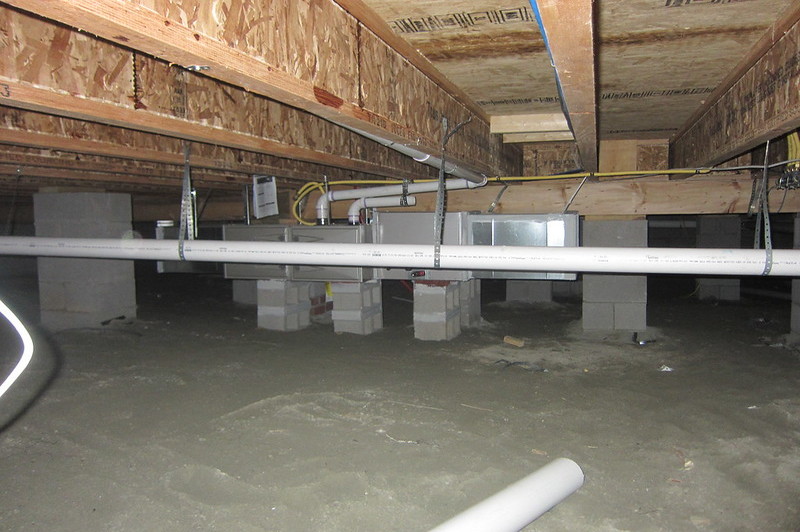If you’re curious about how much mold in crawl space is acceptable, then we’ll answer it for you. A mold-free crawl space is the only way to go.
In this article, you will learn why crawl space mold is an absolute no-no. We hope you’ll read until the end to understand what we mean fully!

What Is A Crawl Space?
Before learning how much mold is acceptable in a crawl space, we must first be familiar with the crawl space. A crawl space is a narrow area used as an access point for electrical, ventilation, and plumbing in a home.
Sometimes crawl spaces are built big enough to install an HVAC unit. Despite it not being a walkable space, it is still accessible for repairs. Crawl spaces can also serve as a storage space for tiles, bricks, and others that aren’t susceptible to moisture.
A good crawl space should have a vapor barrier. The vapor barrier is meant to resist moisture and is especially important in places with dry climates.
If the moisture levels rise, it would be a significant problem. It would be a problem because mold loves moist environments. Mold spores are everywhere, so it would be easy to thrive in narrow areas like crawl spaces.
Moreover, since crawl spaces aren’t regularly checked, you may have significant mold contamination. Here is an article about eradicating mold spores so you do not end up with substantial mold growth.
How do molds grow in a crawl space?
It is pretty common for molds to grow in crawl spaces. They are rarely visited and maintained, so the mold contamination can easily go unnoticed. High moisture and humidity levels are the leading causes of mold growth in crawl spaces.
It’s easy to understand why they’re vulnerable to moisture and humidity. Consider the location of your crawl space; it is below your house and above the ground.
The soil from the ground contains moisture and is a perfect breeding ground for mold. There are different kinds of mold, and the most notorious one is black mold. Here is an article on what black mold looks like to identify it if you encounter it in your home.
How much mold is acceptable in a crawl space?
It only takes one to two for mold to form and reproduce in a damp space. Ideally, it would be great if your crawl space was free from mold since they spread quickly.
Even minor patches of mold are not acceptable. If you notice such clusters, work on identifying the cause. Then, proceed to remove the clumps of mold.
What are the signs of mold growth?
Some signs of mold growth in crawl spaces are greenish-black spots on baseboards. Such spots are signs of moisture issues.
Another sign is warped wooden structures, specifically floors, in your house. If your flooring has water damage, it may affect your crawl space as well.
Of course, wet wooden structures within the area may be a sign of mold damage, too. Lastly, unexplained respiratory problems may also be due to mold contamination in your crawl space.
How to remove mold in the crawl space
There are different ways to remove crawl space mold. You can choose to DIY it or ask for professional help. If the mold growth isn’t extensive, then you can use either of the following:
- Sodium bicarbonate
- Vinegar
- Bleach
You can do the soda blasting method to remove crawl space mold. To do this, fetch a blasting device and use sodium bicarbonate to kill the spores in your narrow area.
If the mold damage is extensive, then we recommend you to leave it to professionals. The cost of crawl space mold removal ranges from $500 to $30,000.
How to prevent mold growth in the crawl space
Since mold grows in moisture-ridden places, the best way to prevent their growth is to maintain moisture levels. Crawl space affects the air we breathe in our homes, so it is essential to keep it mold-free.
The appropriate level of moisture in a crawl space is 55%. You can measure your humidity level using a digital thermo-hygrometer. If it rises to 65%, then you may need to take action.
Check for water in your crawl space since water damage also leads to mold growth. If there is water, look into its source. If it is standing water or bulk water, then it may be due to drainage issues.
If the ground is damp, then it may be a ground moisture evaporation problem. After identifying the root of the problem, have them fixed.
Consider changing your pipes if you have a leak. However, if the problem is from the outside, consider a sump pump.
Sump pumps help prevent basement flooding, which is why they are essential in your home. However, check them thrice a year to ensure their state. Lastly, install a crawl space dehumidifier to ventilate the crawl space properly.
Conclusion
Mold causes numerous problems in your home. It ruins your home’s integrity and puts your health at risk.
Considering the damage that mold poses in homes, it is only natural to want to learn about how much mold in crawl space is acceptable. We hope this article about crawl space mold was of help to you.
